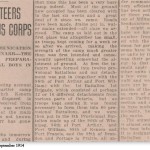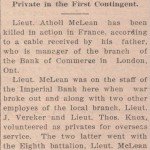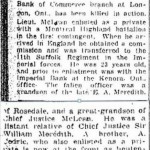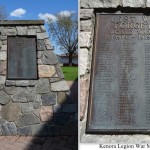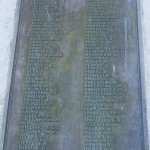
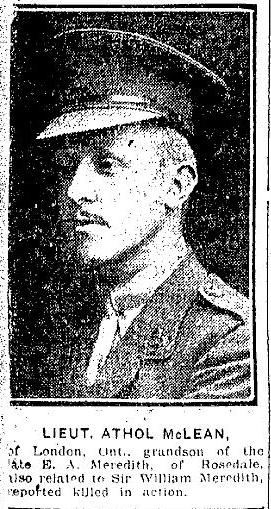
| Personal Details | |
| Date of Birth | October 28, 1894 |
| Place of Birth | London |
| Country | Canada |
| Marital Status | Single |
| Next of Kin | A.D. McLean (father), Bank of Commerce, London, Ontario |
| Trade / Calling | Bank Clerk |
| Religion | Presbyterian |
| Service Details | |
| Regimental Number | 25107 |
| Service Record | Link to Service Record |
| Battalion | 11th Battalion, Suffolk Regiment |
| Force | British Army |
| Branch | British Infantry |
| Enlisted / Conscripted | Enlisted |
| Place of Enlistment | Valcartier, Quebec |
| Address at Enlistment | Kenora, Ontario |
| Date of Enlistment | September 22, 1914 |
| Age at Enlistment | 19 |
| Theatre of Service | Europe |
| Prisoner of War | No |
| Survived War | No |
| Death Details | |
| Date of Death | July 1, 1916 |
| Age at Death | 21 |
| Buried At | Bécourt Military Cemetery, Somme, France |
| Plot | I. Q. 5. |
McLean, Athol Archibald
The Battle of the Somme lasted from 1 July to 18 November 1916 and resulted in over a million casualties for all the forces involved. The Germans refer to the battle as ‘the blood bath’ and the Somme has been called the graveyard of armies. On the first day alone the British army suffered 57,000 casualties including 19,000 men killed, making it the worst day in their history. One of the fallen was a Canadian officer, Second Lieutenant Athol Archibald McLean, who was killed in action on the first day of the battle.
Athol was born on 28 October 1894 in London, Ontario, the son of Archibald Duncan McLean and Alice Louisa Meredith. Archibald and Alice were both born in Ontario, called Canada West at the time, and they were married in 1889 in Toronto. Athol was the third of their five sons: Duart Meredith (1891, died as a child), Arthur Cedric (1892), Athol (1894), Basil Meredith (1896) and Ronald Griffin (1899). When the boys were growing up the family lived in Toronto, Sarnia and London, Ontario. Their father had a long career with the Bank of Commerce, starting as a clerk then becoming an accountant and manager. Athol followed in his father’s footsteps and in 1914 when the war started he was living in Kenora, Ontario and working as a clerk at the Imperial Bank (located in the Brydon Block).
Britain declared war on 4 August 1914 and three days later mobilization orders were issued in Canada. Officers and volunteers were told to go to Valcartier, an area northwest of Quebec City that would become the site of a large military camp. Athol and two fellow bank employees, Jeffrey Vereker and Thomas Knox, left Kenora on 23 August 1914 along with about 40 other volunteers. The local newspaper reported that thousands of people turned out to cheer and support the men as they left. At Valcartier they underwent training, medical tests and inoculations. Athol’s medical exam tells us he was 5’10” with fair hair and blue eyes and he was found fit for service. He enlisted with the 13th Battalion (5th Royal Highlanders) in Valcartier on 23 September and a short time later the battalion embarked for England as part of the 1st Canadian Contingent. The convoy of 32 transport ships was protected by a Royal Navy escort because of the danger from German submarines and they arrived safely in Plymouth, England on 14 October 1914.
The Canadians were sent to train at Salisbury Plain in southern England and in May 1915 Athol was transferred to the 17th Battalion. He took officer’s training and according to a letter written by his co-worker, Jeffrey Vereker, there was a shortage of officer positions in the Canadian units. The lads sought their commissions with the British Army and on 1 July 1915 Athol became a Second Lieutenant with the 11th Battalion (Cambridgeshire), Suffolk Regiment. He was listed in the London Gazette on 13 July 1915, ‘The Suffolk Regiment. 11th Battalion (Cambridgeshire) – Atholl Archibald McLean to be temporary Second Lieutenant. Dated 1st July, 1915.’ The commission was listed as temporary as it was subject to the approval of his commanding officer.
In December 1915 the British and French began to plan a large-scale joint assault on the Germans. By February 1916 they had decided the combined operation would take place that year near the Somme River in France. The opening offensive, the Battle of Albert, began at 7:30 am on 1 July 1916 with both British and French divisions taking part. By the end of the day 19,000 British soldiers had been killed. Another 35,000 were wounded and over 2,000 were missing. Among the dead was Second Lieutenant Athol McLean.
Athol is buried in Bécourt Military Cemetery near the town of Albert in France. He is commemorated on the Imperial Bank of Canada Honour Roll, the Cenotaph in Kenora, the Kenora Legion War Memorial and on page 572 of Canada’s First World War Book of Remembrance. The book is displayed in the Peace Tower on Parliament Hill in Ottawa.
All three of Athol’s brothers served during the war. Arthur Cedric enlisted in August 1915 and was commissioned as a Lieutenant with the Royal Engineers. He served in England and France and became seriously ill with influenza in the fall of 1918. He survived the war and returned home in February 1919 with a war bride. Basil Meredith, a chemist, was called up in October 1918, a month before the Armistice, and he served in Canada with the 1st Central Ontario Regiment. Ronald Griffin enlisted in Ottawa in May 1918, at age 19, and he served in England with the 1st Canadian Tank Battalion.
Their father passed away in March 1923, at age 63, and he’s buried in the Mausoleum at Woodland Cemetery in London, Ontario. Their mother died in 1945 and she’s buried in St. James Cemetery in Toronto.
Family History Notes
Athol’s 2xgreat-grandfather was Hon. Colonel Neil McLean of Mingary, Scotland, an officer in the 84th Regiment (Royal Highland Emigrants). He immigrated to Quebec and served with his regiment during the American Revolution and the War of 1812. He also held positions as sheriff, militia colonel, justice of the peace and judge. Colonel McLean married Isabella MacDonell in 1784. They lived in St. Andrew’s, Upper Canada and they had eight children.
Athol’s great-grandfather Archibald McLean was born in April 1791 in St. Andrew’s. He fought in the War of 1812 with the 3rd Regiment of York and was severely wounded at the Battle of Queenston Heights. After recuperating he fought at the Battle of Lundy’s Lane. He was captured by the Americans and spent the rest of the war as a prisoner. Archibald became a lawyer and judge and served as Chief Justice and Speaker of the House. He was married to Joan McPherson of Trois-Rivières, Quebec.
Joan’s nephew, George McPherson Sr., worked for the Hudson’s Bay Company and managed the HBC trading post at Rat Portage (Kenora) from 1858 to 1871. After his retirement he ran a private trading post at the Northwest Angle on Lake of the Woods. George was also an interpreter and witness for Treaty No. 3 in 1873. His grandchildren married into local families like the Bouchas and today the McLeans have hundreds of distant relatives in the Kenora area.
By Becky Johnson (3rd cousin 3x removed to Athol)
Photo at the top is from the Toronto Star, 13 July 1916 page 12.




